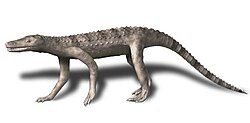Crocodylomorph
The Crocodylomorphs are an important group of archosaurs. It includes the crocodilians and their extinct relatives. They were the only members of Pseudosuchia to survive the end-Triassic extinction.
| Crocodylomorphs Temporal range: Upper Triassic–Recent, 235–present.
| |
|---|---|

| |
| Skeleton of Terrestrisuchus, an early crocodylomorph | |
| Scientific classification | |
| Unrecognized taxon (fix): | Crocodylomorpha |
During Mesozoic and early Tertiary times the Crocodylomorphs were much more diverse than they are now.
They were originally small, lightly built, active land animals. These were replaced during the early Jurassic by various aquatic and marine forms. The later Jurassic, Cretaceous, and Tertiary saw a wide diversity of terrestrial and semi-aquatic lines.
Modern crocodilians do not appear until the Upper Cretaceous.
Evolutionary history
The crocodylian lineage (clade Crurotarsi) were a very diverse group of reptiles. Not only are they an ancient group of animals, at least as old as the dinosaurs, they also evolved into a great variety of forms.[1]
The earliest forms, the sphenosuchians, evolved during the Upper Triassic. They were slim land animals built like greyhounds. During the Jurassic and the Cretaceous, marine forms evolved forelimbs that were paddle-like and had a tail similar to modern fish.
The group had a wider range of habitats and behaviours than it does at present. Dakosaurus andiniensis, a species closely related to Metriorhynchus, had a skull adapted for eating large marine reptiles. Several terrestrial species during the Cretaceous evolved herbivory. A number of lines during the Tertiary and Pleistocene became wholly land predators.
Classification
- Sauropsida
- Archosauria
- Ornithodira (pterosaurs+dinosaurs)
- Crurotarsi
- Crocodylomorpha
- Archosauria
Crocodylomorph Media
References
- ↑ Nesbitt S.J. 2011. The early evolution of archosaurs: relationships and the origin of major clades. Bulletin of the American Museum of Natural History. 352: 1–292.





